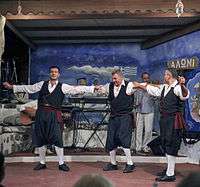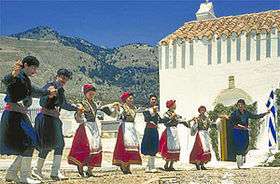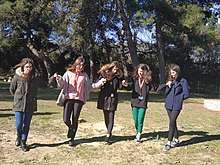Greek dances
Greek dances (horos) is a very old tradition, being referred to by authors such as Plato, Aristotle, Plutarch and Lucian.[1] There are different styles and interpretations from all of the islands and surrounding mainland areas. Each region formed its own choreography and style to fit in with their own ways. For example, island dances have more of a different smooth flow to them, while Pontic dancing closer to Black Sea, is very sharp. There are over 10 000 traditional dances that come from all regions of Greece. There are also pan-Hellenic dances, which have been adopted throughout the Greek world. These include the syrtos, kalamatianos, pyrrhichios, hasapiko and sirtaki.
| Music of Greece | |
|---|---|
 | |
| General topics | |
| Genres | |
| Specific forms | |
| Media and performance | |
| Music awards |
|
| Music charts | |
| Music festivals | |
| Music media |
|
| Nationalistic and patriotic songs | |
| National anthem | "Hymn to Liberty" |
| Regional music | |
| Related areas | Cyprus, Pontus, Constantinople, South Italy |
| Regional styles |
|
Traditional Greek dancing has a primarily social function. It brings the community together at key points of the year, such as Easter, the grape harvest or patronal festivals; and at key points in the lives of individuals and families, such as weddings. For this reason, tradition frequently dictates a strict order in the arrangement of the dancers, for example, by age. Visitors tempted to join in a celebration should be careful not to violate these arrangements, in which the prestige of the individual villagers may be embodied.[2]
Greek dances are usually performed in diaspora Greek communities among international folk dance groups.
Ancient Greek dances

- Antistrophe
- Carpaea
- Choreia (dance)
- Cordax
- Dionysiakos
- Hyporchema
- Korybantes
- Pyrrhichios (dance)
- Syrtos
Modern and regional dances
Aegean Islands




The Aegean islands have dances which are fast in pace and light and jumpy. Many of these dances, however, are couples dances, and not so much in lines. See Nisiotika for more information.
- Antikristos (Mytilene)
- Antipatitis (Karpathos)
- Arkistis (Karpathos)
- Ballaristos
- Ballos (Naxos), Kythnos)
- Boniatiki Sousta (Rhodes)
- Chaniotika (Leros)
- Ikariotikos (from Ikaria)
- Irene (Tilos)
- Isios (Kalymnos)
- Kamara (Skiathos)
- Kamares (Tilos)
- Karavas (dance) (Naxos)
- Kato Choros (Karpathos)
- Kechagiadikos (Lemnos)
- Kefalonitika (Karpathos)
- Kritikos (Rhoditiko Pidikto) (Rhodes)
- Leriki Sousta (Leros
- Lerikos (Leros)
- Michanikos (Kalymnos)
- Ola Ta Poulakia (Thasos)
- Panagia (Lemnos)
- Pano Choros (Karpathos)
- Patma (Lemnos)
- Pirgousikos (Chios)
- Plataniotiko Nero (Samos)
- Rhoditiki Sousta (Rhodes)
- Rhoditikos (Rhodes, Leros)
- Rodo (dance)
- Sianos (Karpathos)
- Simetherkatos (Lemnos)
- Samiotiki Sousta (Samos)
- Sousta (Kalymnos)
- Sousta Karpathou (Karpathos)
- Sousta Koaki (Kos)
- Sousta Tilou (Tilos)
- Sperveri (Rhodes)
- Strose Vayia (Samos)
- Symiaki Sousta (Symi)
- Syrtos
- Syrtos Assos (Agathonisi)
- Ta Xila (Mytilene)
- Thermiotikos Karsilamas (Kythnos)
- Thimariotikos (Kalymnos)
- Tourtsikos (Rhodes)
- Trata
- Tsopanikos (Lemnos)
- Zervos (Karpathos)
Crete

These dances are light and jumpy, and extremely cardiovascular.
- Angaliastos
- Anogianos Pidichtos
- Apanomeritis
- Ethianos Pidichtos
- Ierapetrikos Pidichtos
- Kanella
- Katsabadianos
- Laziotis
- Maleviziotis
- Mikro Mikraki
- Ntames
- Ntournerakia
- Pentozali
- Pidichtos Lasithou
- Pyrrhichios
- Priniotis
- Rethemniotiki Sousta
- Rodo (dance)
- Siganos
- Sitiakos Pidichtos
- Sousta
- Syrtos Chaniotikos
- Trizali
- Xenobasaris
- Zervodexios
Central Greece
- Antikristos
- Hasapiko
- Sirtaki
- Hatzichristos (from Megara)
- Kalamatianos
- Zeibekiko
- Kamilierikos
- Kavodorikos (Karystos)
- Kleistos
- Pyrrhichios
- Syrtos
- Lambri Kamara (Megara)
- Loulouvikos (from Megara)
- Tis Triantafilias Ta Fila (Megara)
- Trata (from Megara)
- Tsamikos
Epirus

Epirote dances are the most slow and heavy in all of Greece. Great balance is required in order to perform these dances.
- Berati
- Tsamikos
- Fisounis
- Genovefa
- Giatros
- Horos Tis Nifis or Lipothimarikos
- Kapitan Louka
- Koftos
- Klamata
- Metsovitikos
- Palamakia
- Papadia
- Papiggo
- Parzakana
- Pogonisios
- Sta Dio
- Sta Tria
- Singathistos Metsovou
- Zagorisios
Peloponnese
The dances of the Peloponnese are very simple and heavy, with the leader of the line improvising.
- Ai Georgis
- Diplos Horos
- Geranos
- Kalamatianos
- Maniatikos
- Monodiplos
- Panagiotis (dance)
- Syrtos
- Tsakonikos
- Tsamikos
Ionian Islands

- Ai Georgis (Corfu)
- Ballos (Lefkada)
- Bourdaris (Kythira)
- Cerigotikos (Kythira)
- Potamitikos (Kythira)
- Ai Georgis (Kythira)
- Divaratikos (Cefalonia)
- Fourlana (Corfu)
- Kerkiraikos (Corfu)
- Lefkaditikos (Lefkada)
- Levantitikos (Zakynthos)
- Mermigas (Cefalonia)
- Mesaritikos (Kythira)
- Rouga (Corfu)
- Syrtos (Cefalonia)
- Thiakos (Lefkada)
Macedonia
Dances in Macedonia vary. Most are solid and are performed using heavy steps, whilst others are fast and agile. Most dances begin slow and increase in speed.
Western Macedonia
- Akritikos (Florina)
- Antikristos
- Bougatsas (Florina)
- Dimitroula
- Diplos Choros Tis Rokas
- Gaida Dance
- Gerakina
- Gerontikos
- Endeka Kozanis
- Kastorianos
- Kori Eleni
- Kapitan Louka
- Hasapiko
- Leventikos (Florina)
- Makedonikos antikristos
- Makrinitsa dance
- Nizamikos (Naousa)
- Omorfoula (Florina)
- O Nikolos
- Partalos
- Poustseno
- Proskinitos
- Raikos (Edessa)
- Servikos
- Simbethera (Florina)
- Stamoulo
- Stankina (Edessa)
- Syre Syre (Edessa)
- Syrtos Makedonias
- Tis Dimitroulas
- Tis Marias
- Tranos Choros (Kozani)
- Trita Pata (Naousa)
- Tsotsos (Florina)
- Tsourapia (Florina)
- Zacharoula
- Zaramo (dance)
Eastern Macedonia
- Antikristos
- Drousas
- Kampana
- Kori Eleni
- Tefkotos
Thessaly
Dances in Thessaly are similar in style to the dances of Epirus. Mostly heavy, and some are fast. The leader, however, improvises, just like those in the Peloponnese.
- Dionysiakos
- Gaitanaki
- Galanogalani
- Girogalakis
- Kalamatianos
- Kamara
- Kangeli
- Karagouna
- Kleistos
- Kleistos Argitheas
- Koftos
- Lafina
- Pilioritikos
- Rougatsiarikos
- Souzana
- Syrtos
- Tsamiko
- Tsamikos Deskatis
- Zacharoula
Thrace
Thracian dance is generally skippy and light. In most Thracian dances, the men are only permitted to dance at the front of the line. Musicians and singers such as Hronis Aithonidis and Kariofilis Doitsidis have brought to life the music of Thrace.
- Antikristos
- Baidouska
- Daktili
- Dendritsi
- Drista
- Gaitani
- Giknas
- Hasapia
- Koulouriastos
- Mandilatos
- Papisios
- Singathistos
- Syrtos
- Tapeinos Horos
- Tapeinos Paschaliatikos
- Tripati
- Zonaradiko
Northern Thrace / Eastern Thrace
The dances of (Northern Thrace) are fast, upbeat and similar to the Thracian style of dance. Dances from the town of Kavakli and Neo Monastiri are the most popular.
- Antikristos
- Bogdanos
- Douzikos
- Kallinitikos
- Katsivelikos
- Kinigitos
- Koutsos
- Miliso
- Podaraki
- Sfarlis
- Singathistos
- Stis Treis
- Syrtos Banas
- Tamzara
- Tremouliastos
- Troiro
- Tsestos
- Zervos
- Zervos Banas
- Zervodexios
- Zonaradiko
Pontus
The dances of the Pontic Greeks from the Black Sea, were mostly performed by Pontian soldiers in order to motivate themselves before going into a battle. The dances are accompanied by the Pontian lyra, also called kemenche by Turkish people. See Horon for more information on the history of these dances.
- Aneforitissa Kizela
- Apo Pan Kai Ka Matsouka
- Atsiapat
- Dipat
- Etere Trapezounta
- Fona Argyroupolis
- Gemoura
- Getiere Argyroupolis
- Kalon Koritsi
- Kochari
- Kori Kopela
- Kounichton Nikopolis
- Kousera
- Lafraga
- Letsi Kars (Kars)
- Letsina Kars (Kars)
- Macheria
- Militsa
- Miteritsa
- Momoeria
- Omal
- Patoula
- Podaraki
- Pontic Serra
- Sampson (Samsun)
- Seranitsa
- Siton Imeras
- Syrtos
- Tamsara Nikopolis
- Tamsara Trapezountas
- T'apan Ke Ka Matsouka
- Tik Diplo
- Tik Imeras
- Tik Mono
- Tik Nikopolis
- Tik Togias or Togialidikon
- Titara Argyroupolis
- Tria Ti Kotsari
- Trigona Kerasountas
- Trigona Matsoukas
- Trigona Trapezountas
- Tripat Matsouka
- Tromakton
- Tyrfon or Tryfon Bafra
Asia Minor
|
Cappadocia The Cappadocian dances were mainly sung in the Cappadocian dialect of Cappadocian Greeks or the Karamanlides. Dances varied from social dances to ritualistic dances.
|
Sinasos The Dances & Songs of Sinasos Mustafapasa.
|
Constantinople
- Byzantine dance
- Hasapiko
- Tesera Matia
- Patinada Nyfis
- Rododachtilos
Cyprus
|
Men's Dances
|
Women's Dances
|
Aromanians
- Antipera
- Hatzistergiou
- Kalamatianos
- Kato Stin Aspri Petra
- La Valia di Giannena
- Sta Tria
- Syrtos
Sarakatsani
- Apano Stin Triantafilia
- Choros Katsa
- Despo
- Diplos Choros
- Sta Tria
- Tsamikos
Greek Dancing in the United States
Within the United States, Greek Americans participate in Greek dancing in order to preserve their heritage and culture. Greeks of all ages can be seen showcasing their skills at Greek Festivals which take place year round, often hosted by Greek Orthodox Churches, or at various competitions in which groups practice dances from specific parts of Greece in order to perform in front of judges.
Greek Orthodox Folk Dance & Choral Festival (FDF)
Since 1976, the Greek Orthodox Metropolis of San Francisco has held a convention that allows Greek Dance groups from various churches in the Pacific Region of the United States to compete. Up to 3,000 people participate annually and it is described as the largest youth ministry program in the Metropolis of San Francisco.[3] Within the competition, there are four divisions, two of which are judged and two of which are exhibition suites. Division I and Division II are judged by a table of judges who have done years of research in Greece and instructed others on the styling and other important elements of Greek dancing. Each competing team will be placed into a division and group based on the average age of the team.[4] Each team performs two times and perfected suites that can be from many places in Greece (islands, mainland, villages) and feature many different dances. The judges will score the teams based on their costumes, singing, stage presence, styling, and how closely it resembles the region that their suite is from.
See also
References
- Raftis, Alkis, The World of Greek Dance Finedawn, Athens (1987) p25.
- Raftis, Alkis, The World of Greek Dance Finedawn, Athens(1987) p117.
- "FDF 2020". Your FDF. Retrieved 2020-02-19.
- McGuire, Tim. "FDF Categories". Your FDF. Retrieved 2020-02-19.
External links
- Video Examples of Regional Greek Dances